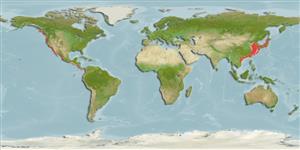Cystodytes lobatus (Ritter, 1900)
Lobed tunicate| Native range | All suitable habitat | Point map | Year 2050 |

|
| This map was computer-generated and has not yet been reviewed. |
| Cystodytes lobatus AquaMaps Data sources: GBIF OBIS |
Google image |
No photo available for this species.
Classification / Names Common names | Synonyms | CoL | ITIS | WoRMS
Ascidiacea | Aplousobranchia | Polycitoridae
Environment: milieu / climate zone / depth range / distribution range Ecology
Sessile; depth range 0 - 200 m (Ref. 865). Subtropical
Distribution Countries | FAO areas | Ecosystems | Occurrences | Introductions
Eastern Pacific: Canada to Mexico. Temperate to subtropical.
Length at first maturity / Size / Weight / Age
Maturity: Lm ? range ? - ? cm
Life cycle and mating behavior Maturity | Reproduction | Spawning | Eggs | Fecundity | Larvae
Main reference
References | Coordinator | Collaborators
Tokioka, T. 1963 Contributions to Japanese Ascidian fauna. XX. The outline of Japanese ascidian fauna as compared with that of the Pacific Coasts of North America. Publ. Seto mar. Biol. Lab. 11:131-156. (Ref. 3705)
IUCN Red List Status
(Ref. 130435: Version 2025-1)
CITES status (Ref. 108899)
CMS (Ref. 116361)
Threat to humans
Human uses
| FishSource |
Tools
More information
Diet composition
Food consumption
Predators
Max. ages / sizes
Length-weight rel.
Length-length rel.
Length-frequencies
Mass conversion
Abundance
Internet sources
BHL | BOLD Systems | CISTI | DiscoverLife | FAO(Publication : search) | Fishipedia | GenBank (genome, nucleotide) | GloBI | Gomexsi | Google Books | Google Scholar | Google | PubMed | Tree of Life | Wikipedia (Go, Search) | Zoological Record


